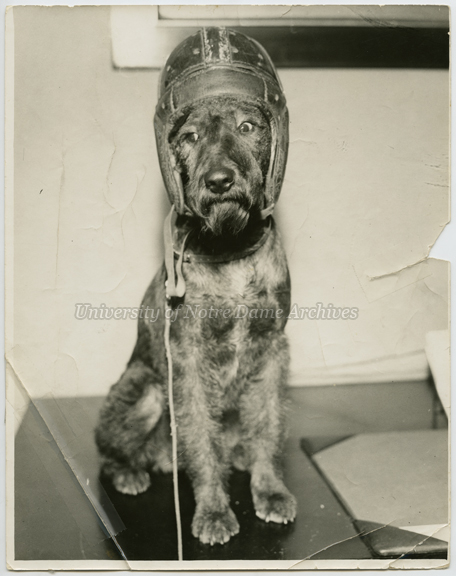
In October of 1932, dog breeder Charles Otis and his partner Thomas Bolton announced that they were going to donate an Irish Terrier to Notre Dame to serve as mascot for the football team. According to an advertisement in a 1934 football program, Otis had also presented Irish Terriers to celebrities such as Amelia Earhart and Will Rogers. This was at a time when Notre Dame didn’t have a consistent mascot. The Alumni Club of Toledo had presented two Irish Terriers both named Tipperary Terrence in 1924, but it doesn’t seem to be something Notre Dame pursued on its own.
Otis presented Brick Top Shaun Rhue to Football Coach Heartley “Hunk” Anderson during the Navy game, which was played in Otis’s hometown of Cleveland on November 19, 1932. Shaun Rhue (“Old Red”) traveled with the team for the last two remaining games of the season – to New York for the Army game and to Los Angeles for USC.

Caption: “With affectionate regards to Shaun Rhu and the College of Notre Dame. Best hopes and wishes from Chas. A. Otis.”
Shaun Rhue was born on January 14, 1932, so he was still a bit of a pup when given the task of Notre Dame mascot. He stayed briefly with Hunk Anderson and then Athletic Trainer Eugene “Scrapiron” Young before moving to campus at the request of University President Rev. Charles O’Donnell: “I should like to have the dog on the campus and get acquainted with him. He quite won my heart in the few glimpses I have had of him thus far. As a mascot he made the Army mule look pretty sick last Saturday” [O’Donnell to Otis, 12/01/1932, UPCO 6/121]. O’Donnell continued in his next letter, “When the season is over, he will be installed on the campus as a regular member of the family, and have the freedom of the city, so to speak. The only danger that will ever threaten him is that he may be spoiled by kindness. Everybody loves him” [O’Donnell to Otis, 12/09/1932]. Otis was glad to hear Shaun Rhue was doing well, but warned O’Donnell not to overfeed the dog.
Otis sent Fr. O’Donnell Shaun Rhue’s papers, which are preserved in the University Archives. His Certificate of Pedigree lists his lineage back to his great, great grandparents. The Certificate of Entry into the American Kennel Club also transfers ownership to Notre Dame. Otis told O’Donnell that Shaun Rhue was a fine specimen of his breed and would likely win in dog shows. It is unknown, and probably unlikely, if Notre Dame showed Brick Top Shaun Rhue.



Other than these few documents announcing the arrival of Brick Top Shaun Rhue to Notre Dame, there is unfortunately not much mention of him later in Scholastic or elsewhere. It is thought that he simply ran away from campus in the spring of 1933. If so, Shaun Rhue may have never graced the sidelines of Notre Dame Stadium, but the idea of Irish Terriers as Notre Dame’s mascot would persist. In the fall of 1935, William Butler presented Notre Dame with another Irish Terrier – Clashmore Mike, who would remain at Notre Dame for ten years and garner much publicity.

In the fall of 1936, Scholastic attempted to trace the history of Irish Terriers mascots at Notre Dame. Within the span of a short twelve years, Tipperary Terrence I and II were lost from the institutional memory altogether and there was only a vague recollection of Brick Top Shaun Rhue:
“Shaun was a likable dog in many ways, but also had a few bad traits. He, like many students, enjoyed nothing better than a little vacation in the form of a week-end. His week-ends, however, were without official permission and extended not only for the week-end, but for weeks, his latest ‘week-end’ extending from the spring of 1933 until now. His mental alertness was also of the questionable quality as he was often known to stand nonchalantly in the path of oncoming cars, only escaping injury and death because of the driver’s quick action with the brakes.
Official mascots prior to Shaun Rhue’s time were unknown, at least in the opinion of ‘old timers’ connected with the University. Many, on being questioned concerning the existence of mascots at the University, merely shrugged their shoulders in a dubious manner.” [Scholastic, October 23, 1936, page 19].
Sources:
Scholastic
UPCO 6/121
UPCO 8/01






